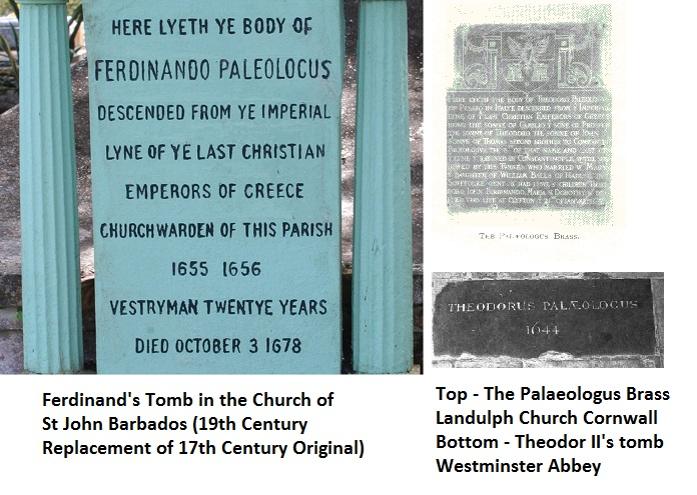FROM CONSTANTINOPLE TO BARBADOS (VIA CORNWALL) - The fate of the last Byzantines
On the 29th of May 1453 Constantine XI Palaeologus, last Emperor of the Byzantines, died fighting the Ottoman Turks besieging his capital. With his death, the 1,000 year history of the Eastern Roman Empire came to an end but not all the imperial family perished in the Fall of Constantinople.
Some of the surviving Palaeologus clan ended up in Italy and in the late 1570s, a young man calling himself Theodore Palaeologus was banished from the Adriatic city of Pesaro after becoming mixed up in a murderous vendetta. Theodore, who claimed descent from the last Byzantine emperor’s brother, then vanishes from sight for several years but he reappears on the Greek Island of Chios, where he married the Byzantine princess Eudoxia Comnenus. In 1594 a daughter (Theodora) was born to this royal couple but Eudoxia must have died soon afterwards because in the late 1590s Theodore pops up in the Netherlands.
Like many landless princes, Theodore often fought as a mercenary and on this occasion he’d sold his sword to the English army helping Dutch rebels overthrow their Spanish-Hapsburg overlords. There’s also strong evidence that Theodore was part of Elizabeth I’s highly effective spy network where the skills he’d learned as a Pesaresi bravo (the original Italian word ‘bravo’ could mean ‘paid assassin’) must have come in handy.
Despite the unsavoury nature of his work, life with the English must have suited Theodore because, on May 1st 1600, he married a wealthy Suffolk heiress named Mary Ball. He continued to serve his adopted country well into the 1620s but, as the years began to take their toll, he tried to find a post better suited to a man of his age. In a letter dated 9th March 1628, Theodore asks the Duke of Buckingham (a favourite of both James I and Charles I) to find him a position and reminds the noble duke of the ‘good service’ he’d performed for the Prince of Orange as well as his own royal pedigree.
Though Buckingham was himself assassinated in August 1628, Theodore found another patron in his old comrade-in-arms Sir Nicholas Lower and he spent a comfortable retirement in the Cornish village of Landulph near Saltash. He lived at Clifton, Sir Nicholas’ manor house, and died peacefully in 1636. Theodore was survived by three sons and three daughters: his daughter with Eudoxia married a Greek prince in 1614 but his sons with Mary (Theodore II, John and Ferdinand) soon became embroiled in the bitter struggle between Charles I and his parliament.
During the English Civil War [1642-1651] many brothers found themselves in opposing armies and Theodore II, John and Ferdinand Palaeologus were no exception. Despite the royal blood in his veins, Theodore II became a Lieutenant-Colonel in the Parliamentarian Army and served under Oliver, Lord St John. He fought at the battle of Edgehill and, when he was killed in the spring of 1644, Oliver arranged to have his friend’s body interred in the St John family vault inside Westminster Abbey!
By contrast, Theodore II's brothers joined the Royalist forces and fought with a regiment commanded by a relative of their late father’s benefactor. John was killed at the Battle of Naseby [1645] but, after Charles I’s defeat and execution, Ferdinand escaped to his maternal grandfather’s estates in Barbados. He arrived in 1649 and died thirty years later a prosperous and respected planter. Ferdinand was survived by his son, Theodore III, and he’d left his two sisters behind in England – so what became of them?
A plaque in Landulph’s parish church of St Leonard & St Dilpe chronicles the pedigree of Theodore’s family and records that ‘Maria’ died unmarried in 1674. Dorothy however married William Arundell of St Mellion and died in 1681 but, after this, the English Palaeologus begin to fade from history.
Following the death of his father Ferdinand, Theodore III served in the English navy as a privateer (a sort of licensed pirate) but he was lost at sea c.1694. A few years later, a grandson of Theodora (daughter of Theodore I and Eudoxia) had his claim to the throne of the Byzantine Emperors recognised by the British Government but despite this diplomatic success he died in obscurity.
In the 19th Century, during the Greek War of Independence [1821-1829], the Provisional Government in Athens sent representatives to Cornwall and the Caribbean to search for the descendants of Theodore I. Sadly they found no trace of the ancient Palaeologus bloodline, and the Crown of the Hellenes was offered to a Bavarian prince, but in 2007 a group of Greek Orthodox priests came to Landulph and celebrated Vespers in Theodore’s honour.
